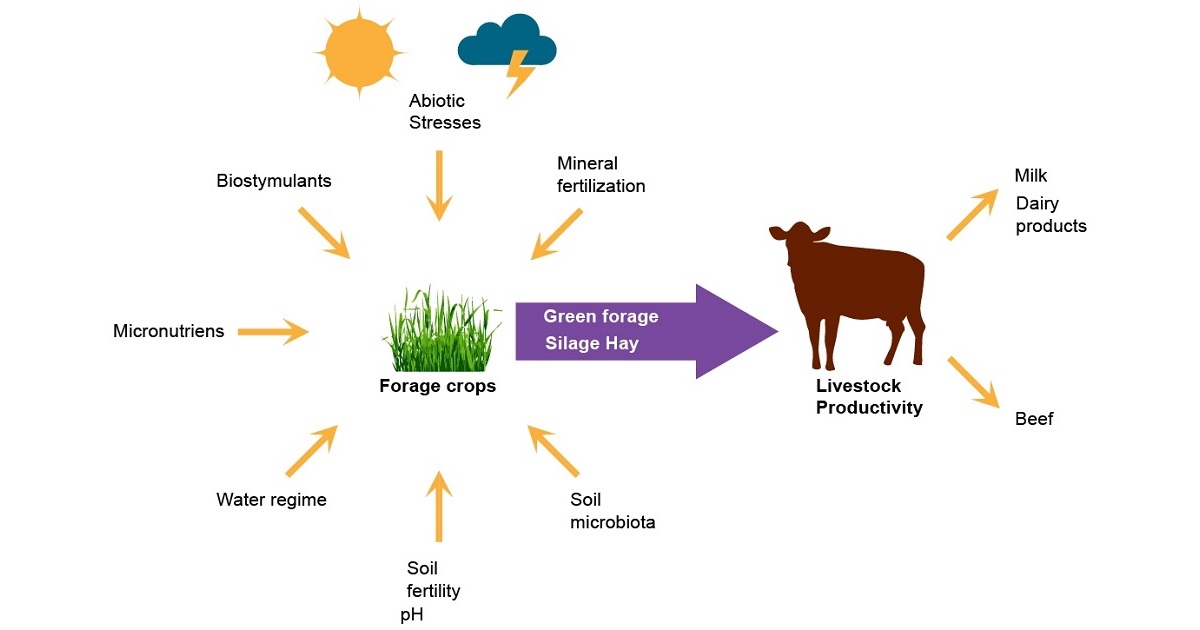Advanced Studies in Improving the Nutritional Status of Forage Crops for Better Livestock Productivity
A special issue of Agriculture (ISSN 2077-0472). This special issue belongs to the section "Farm Animal Production".
Deadline for manuscript submissions: 20 February 2025 | Viewed by 10340

Special Issue Editors
Interests: grasslands management practices; organic farming; forage nutritive value; fertilization; forage conservation; meat and milk quality
Special Issues, Collections and Topics in MDPI journals
Interests: forage grasses; grasslands; fertilization; bioactive fertilizers; Zea mays; sorghum; plant protection
Special Issues, Collections and Topics in MDPI journals
Special Issue Information
Dear Colleagues,
Forage crops refer to plants, usually grasses (Poaceae) or herbaceous legumes (Fabaceae), consumed by animals, particularly livestock. The nutritional status of forage plants depends on the concentration and proportion of carbohydrates, proteins and lipids. The composition of these organic nutrients determines the digestibility of each plant, which, along with minerals and vitamins, provides the amount of energy the animal can obtain. The problem is the presence of anti-nutritional substances and inherent toxins. The quality of feed used in livestock nutrition is very important, as it determines not only the animal’s performance but also the quality of milk and dairy products (butter, cheese and yogurt) and beef. Forage crop quality is determined by genetic constitution and agronomic practices (irrigation management, harvesting stage, the number of cuttings and many others). In addition, climatic changes and abiotic stress factors can also affect forage quality. Nutrient application rate and the source of the nutrient also influence the quality aspect of forage crops. Another important factor is preservation technology involving inherent nutrient losses. For this reason, a wide range of studies on improving the nutritional status of forage crops is carried out.
In this Special Issue, we are looking for publications that can bring together different aspects concerning the improvement of the nutritional status of forage crops. All types of articles, such as original research, opinions and reviews, are welcome.
Dr. Barbara Wróbel
Dr. Waldemar Zielewicz
Guest Editors
Manuscript Submission Information
Manuscripts should be submitted online at www.mdpi.com by registering and logging in to this website. Once you are registered, click here to go to the submission form. Manuscripts can be submitted until the deadline. All submissions that pass pre-check are peer-reviewed. Accepted papers will be published continuously in the journal (as soon as accepted) and will be listed together on the special issue website. Research articles, review articles as well as short communications are invited. For planned papers, a title and short abstract (about 100 words) can be sent to the Editorial Office for announcement on this website.
Submitted manuscripts should not have been published previously, nor be under consideration for publication elsewhere (except conference proceedings papers). All manuscripts are thoroughly refereed through a single-blind peer-review process. A guide for authors and other relevant information for submission of manuscripts is available on the Instructions for Authors page. Agriculture is an international peer-reviewed open access semimonthly journal published by MDPI.
Please visit the Instructions for Authors page before submitting a manuscript. The Article Processing Charge (APC) for publication in this open access journal is 2600 CHF (Swiss Francs). Submitted papers should be well formatted and use good English. Authors may use MDPI's English editing service prior to publication or during author revisions.
Keywords
- animal performance
- anti-nutritional factors
- botanical composition of sward
- cultivar breeding
- animal products quality
- digestibility
- livestock diets
- green forage
- fertilization
- silage
Benefits of Publishing in a Special Issue
- Ease of navigation: Grouping papers by topic helps scholars navigate broad scope journals more efficiently.
- Greater discoverability: Special Issues support the reach and impact of scientific research. Articles in Special Issues are more discoverable and cited more frequently.
- Expansion of research network: Special Issues facilitate connections among authors, fostering scientific collaborations.
- External promotion: Articles in Special Issues are often promoted through the journal's social media, increasing their visibility.
- e-Book format: Special Issues with more than 10 articles can be published as dedicated e-books, ensuring wide and rapid dissemination.
Further information on MDPI's Special Issue polices can be found here.
Planned Papers
The below list represents only planned manuscripts. Some of these manuscripts have not been received by the Editorial Office yet. Papers submitted to MDPI journals are subject to peer-review.
Title: Effect of CaSO4 and potassium fertilization on ADF, NDF content and digestibility of a legume-grass mixture sward.
Authors: Zielewicz W.; Wróbel B.
Affiliation: Poznań University of Life Sciences,
Department of Grassland and Natural Landscape Sciences, Dojazd 11, 60-632 Poznań, Poland
Abstract: Calcium sulphate fertilisation has positive effects on heavy clay soils because it increases the rate of water infiltration and reduces the crust on the surface of these soils. The content of aluminium, which is toxic to plants, increases in acidic soils and disturbs the growth of plants’ roots. Calcium sulphate only slightly modifies the soil pH, but it limits the toxic effect of aluminium in soil. When calcium sulphate is applied in the soil solution, complex AlSO4 ions or molecular Al(OH)SO4 compounds are formed, which reduce the harmful effect of aluminium on plants. The use of calcium sulphate improves soil conditions and plant uptake of mineral nutrients. Improved soil conditions have an impact on the quality of the forage and the yield obtained.






